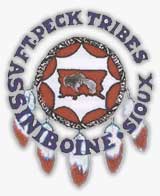Story by Jessica Mayrer
Photos by Kristine Paulsen
Jim Doney’s red baseball cap is tipped back on his head, letting a shock of white hair escape. As he sits beneath a painting of a battle-weary Indian warrior leaning over his horse, he looks boyish in contrast. He’s all business, though, thumbing through a pile of yellowed papers in search for the one that he says shows how the Bureau of Indian Affairs took his land.
Doney, 72, wrote letters for more than 15 years to anyone who would listen and to many who would not. In 1989, he says, the BIA forced him to lease his property to a white rancher who ran hundreds of cattle there and killed the ancient cottonwood trees on his land. Spread across the plastic tablecloth in Doney’s kitchen are letters from the Congressmen who, he says, finally helped him claim his land after years of struggle.
Three generations of his family have ranched on the Fort Peck Reservation in northeastern Montana. His sons were born and learned to walk here. In high school, after dinner, they took their girlfriends to the bluffs just over there, above the small pink house that Doney still calls home. Sipping from a mug of coffee, he looks out over the parched blanket of earth that he has fought to call his own.
Doney’s trouble started in 1981. That’s when he bought two properties to add onto his existing 40-acre lot. Married with growing sons, Doney, who is both Sioux and Assiniboine, wanted to expand his Black Angus cattle operation.
The reservation was allotted in 1908, giving every eligible tribal member 320 acres of land. What was termed “surplus” land — 1.3 million acres — was put up for sale to settlers. As ownership has passed to later generations, some of the land became so fragmented that owners are left with parcels no bigger than a thumbtack. It’s the BIA’s job to manage those parcels for the benefit of the many owners. It’s not a simple task.
Doney bought an additional 60 acres in a parcel that totaled 80 acres. The remaining 20 acres were owned by someone else. No fence separated the two property owners’ lands, nor could the owners agree just where their properties were split.
The other owner, Eunice Davis, rented her portion of the lot to rancher Jed Tihista. Doney claims Tihista dumped sewage on the shared lot and released hundreds of cows to graze on Doney’s property.
“The timber is dying because he had over 500 head of cows over there on what — 35 acres, 37 acres?” says Mike Doney, Jim’s son. “The value of the ground just took a nosedive.”
Tihista acknowledges the BIA did enact a “forced lease” for a short time that enabled him to rent Doney’s land without his approval. But, he says, the damage to Doney’s land is from Doney’s neglect. And, Tihista says, he only grazed 200 cows at a time, nothing close to the 500 that the Doneys claim.
But experts agree even that number is excessive. A sustainable number of cattle on a plot of 40 acres, for example, is approximately 13 cow/calf pairs, even in the winter when grazing is less harmful to the land, says Jeff Mosley, range management specialist from Montana State University.
Yet Tihista insists that if Doney had properly cared for the property after the cattle were removed it would have regenerated.
The BIA has bent over backward to help Doney, he adds.
“He’s dreaming; he’s senile,” Tihista says. “Jim has never been pushed around by that Indian agency.”
Situations like Doney’s happen all of the time on the reservation, says Michelle Buck Elk, a realty officer from the BIA in Poplar.
But “it’s too late to do anything about it now,” Buck Elk says. “It’s been a hundred years in the making and they think that they are going to solve that overnight.”
Because the BIA controls Indian lands, holding them in trust for Indian owners, its agents make the final decisions in property issues.
After 1989, Doney never agreed to rent land to Tihista and never signed a lease, he says.
In letter after letter he called on the BIA to stop insulting him and his land. He also asked why a non-Indian was allowed to lease land before a native on an Indian reservation.
“Everyone will say they can’t do that, they can’t do that — but they do,” Mike Doney says. “If you’re an Indian, and it’s Indian ground, we have first rights to lease it.
“We’ve owned this land; we’ve been kicked off it.”
In practice, if a land dispute between multiple owners arises, the BIA will award the lease to the highest bidder, Indian or not. This is called a “forced lease.” When two or more owners cannot agree, the BIA superintendent is legally obligated to rent the land.
The problem actually lies deep in the U.S. government’s policy toward Indian landowners, says Terry Janis, program officer for the Indian Land Tenure Organization, a Minnesota group that aims to keep Indian land in Indian hands.
The whole system is based on old laws and racist principles, “the idea of Indians as savage,” he says. The BIA acts as a parental figure, overseeing Indian-owned lands by holding them in trust, as with a child not yet ready for the checkbook, Janis says.
The BIA’s paternal role over Indian people is rooted in the Supreme Court case Cherokee Nation v. Georgia. In that decision Justice John Marshall defined the relationship between Indians and the United States: “They are in a state of pupilage. Their relation to the U.S. resembles that of a ward to his guardian.”
This is the language, penned in 1831, that is responsible for creating the legal institutions and mechanisms that exist today, Janis says.
Clark Madison, BIA regional realty officer responsible for oversight of land issues on Fort Peck, says his hands are tied. Everything the BIA does is dictated by law.
Madison says the BIA has spent thousands of dollars of an already tight budget attempting to accommodate Doney.
The reason the BIA leases property for landowners, who are often away from the reservation, is ultimately to prevent trespassing and misuse, and to bring money in for the Indian landowner, he explains.
Tribes have the power to override the forced lease process, Madison says. The American Indian Agricultural Resource Management Act of 1993 gave individual tribes that authority. Tribes can also institute Indian preference on reservation leases. But they generally don’t, and they probably won’t, Madison says, because if they did it would cost many landowners rental income. The Fort Peck Reservation has 531,972 acres of fractionated land, he notes.
The American Indian Probate Reform Act should also address some problems, he says. Implemented in June 2006, it attempts to consolidate land ownership by clarifying Indian inheritance laws and encouraging Indians to write wills.
Doney, after years of writing to U.S. Rep. Denny Rehberg and former Rep. Pat Williams, now has access to all of his land. He got the final piece back 10 years ago, he says, but the trees are permanently destroyed and the land still needs much work to regain its productive state.
“You’ll find very few Indians left on the reservation that are farmers,” Doney says. Remembering the days of his youth, he says, “Christ, there was a lot of Indians in here.”
Madison emphasizes that a lot of the Indians still there are working for other Indians and their interests.
“You’ve got to remember the BIA is almost all Indian,” he says. “We are people just like everyone else. We are trying to do the best we can.”


